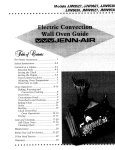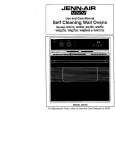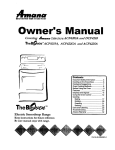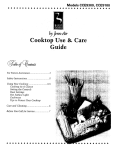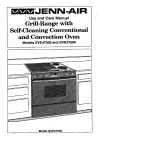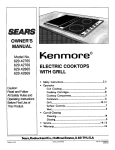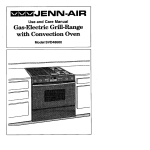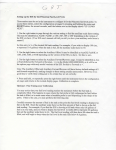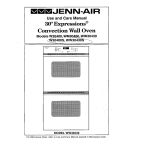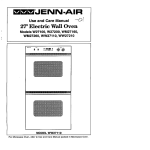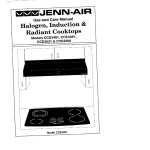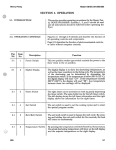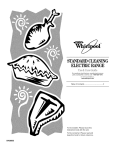Download Jenn-Air Range SCE4340 User's Manual
Transcript
JENN-AIR Use and Care Manual • Solid Element and Radiant Ranges with Convection Models SCE4320 & SCE4340 MODEL SCE4340 About Your Jenn-Air Congratulations on your choice of a Jenn-Air range. Model SCE4320 - Your range has 4 solid elements with thermalimiters. The elements in the rear, designated by a bullseye, are Ultra Power solid elements. The elements in the front, designated by a dot, are standard elements. Model SCE4340 - Your range has 4 radiant elements with thermalimiters. Your Jenn-Air self-cleaning oven combines the best of two cooking methods, convection and radiant bake (conventional) baking or roasting. The Jenn-Air convection oven is actually a conventional oven that circulates heatedair within the oven. As both bake and broil heating elements cycle onand off with the thermostat, a fan keeps the heated air circulating around the food. The constantly recirculating heated air in the convection oven strips away the layer of cooler air that surrounds food. Consequently, many foods cook more quickly. Distributed heat makes multiple rack cooking possible. Convection roasted meats retaintheir natural flavor and juiciness with less shrinkage than radiant bake roasting. In addition to the many exclusive benefits of convection cooking, your Jenn-Air oven is also a fine full featured "bake and broil" oven. You can cook your "old favorite" recipes as you have in the past. The radiant bake oven also gives you the flexibility of preparing various foods when convection cooking may not be as beneficial, as when cooking foods in covered casseroles. The broil element is convenient for top browning and oven broiling of foods. Before youbegin cooking with your new range,please take afew minutesto read and become familiar with the instructions in this book. On the following pages you will find a wealth of information regarding all aspects of using your new range. By following the instructions carefully, you will be able to fully enjoy and properly maintain your range and achieve excellent results with the food you prepare. Should you have any questions about using your Jenn-Air range,write to us. Be sure to provide the model number. Consumer Relations Department Jenn-Air Company 3035 Shadeland Avenue Indianapolis, IN46226-0901 2 SAFETY PRECAUTIONS Read before operating your range All appliances -- regardless of the manufacturer -- have the potential through improper or careless use to create safety problems. Therefore the following safety precautions should be observed: 1. Be sure your appliance is properly installed and grounded by a qualified technician. 2. Never use your appliance for warming or heating the room. 3. Children should not be left alone or unattended in area where appliance is in use. They should never be allowed to sit or stand on any part of the appliance. 4. Wear proper apparel. Loose-fitting or hanging garments should never be worn while using the appliance. 5. Do not repair or replace any part of the appliance unless specifically recommended in this manual. All other servicing should be referred to an authorized Jenn-Air Service Contractor. 6. Flammable materials should not be stored in an oven or near surface units. 7. Do not use water on grease fires. Smother fire or flame or use dry chemical or foam-type extinguisher. 8. Use only dry potholders. Moistor damp potholders on hot surfaces may result in burns from steam. Do not let potholder touch hot heating elements. Do not use a towel or other bulky cloth. 9. Use proper pan size. Many appliances are equipped with one or more surface units of different size. Select cookware having flat bottoms large enough to cover the surface unit heating element. The use of undersized cookware will expose a portion of the heating element to direct contact and may result in ignition of clothing. Proper relationship of cookware to heating element will also improve efficiency and performance. 10. Never leave surface units unattended at high heat settings. Boil over causes smoking and greasy spillovers that may ignite. 5 11. 12. 13. 14. 15. 16. 17. 18. 19. 20. 21. 22. Glazed cookware -- only certain types of glass, glass-ceramic, ceramic, earthenware, or other glazed cookpots are suitable for range top surface without breaking due to the sudden change in temperature. Use only such cookware as you know have been approved for this purpose. Cookware handles should be turned inward and not extend over adjacent surface heating elements to avoid burns, ignition of flammable materials and spillage due to unintentional contact with the cookware. CAUTION -- Do not store items of interest to children in cabinets above a range or on the backguard of a range -- children climbing on the range to reach items could be seriously injured. Do not touch surface units or areas near units, heating elements or interior surfaces of oven. Surface units or heating elements may be hot even though they are dark in color. Areas near surface units and interior surfaces of an oven may become hot enough to cause burns. During and after use, do not touch or let clothing or other flammable materials contact these areas until they have had sufficient time to cool. Other surfaces may become hot enough to cause burns --among these surfaces are the cooktop, the upper door frame and glass, oven vent opening and surfaces near the opening, and the top edge of the control panel. Use care when opening oven door. Let hot air or steam escape before removing or replacing food. Do not heat unopened food containers. Build-up of pressure may cause container to burst and result in injury. Keep oven vent ducts unobstructed. Always place oven racks in desired location while oven is cool. If rack must be moved while oven is hot, do not let potholder contact hot heating element in oven. Do not clean door gasket. The door gasket is essential for a good seal. Care should be taken not to rub, damage or move the gasket. Do not use oven cleaners. No commercial oven cleaner or oven liner protective coating of any kind should be used in or around any part of the oven. Clean only parts listed in this manual and use procedures recommended. Before self-cleaning the oven, remove broiler pan and other utensils. 23. Listen for fan. A fan noise should be heard during the cleaning cycle. If not, call a serviceman before self-cleaning again. 24. Do not cook on glass-ceramic cooking surface if the cooktop is broken. Cleaning solutions and spillovers may penetrate the broken cooktop and create a shock hazard. Contact an authorized Jenn-Air Service Contractor. 25. Clean glass-ceramic cooktops with caution. Ifwet sponge or cloth is used to wipe spills on a hot cooking area, be careful to avoid steam burns. Some cleansers can produce noxious fumes if applied to a hot surface. 26. Do not operate with damaged cooking element after any product malfunction until proper repair has been made. 27. Keep all switches "OFF" when unit is not in use. 28. Do not allow aluminum foil or meat probes to contact heating elements. 29. WARNING: To reduce the risk of tipping of the appliance, the appliance must be secured by properly installed anti-tip devices. To check ifdevices are installed properly, remove the access panel and verify that the anti-tip devices are engaged. IMPORTANT SAFETY NOTICE AND WARNING The California Safe Drinking Water and Toxic Enforcement Act of 1986 (Proposition 65) requires the Governor of California to publish a list of substances known to the State of California to cause cancer or reproductive harm, and requires businesses to warn customers of potential exposures to such substances. Users of this appliance are hereby warned that when the oven is engaged in the self-clean cycle, there may be some low level exposure to some of the listed substances, including Carbon Monoxide. Exposure to these substances can be minimized by properly venting the range to the outdoors during the self-clean cycle. Cooktop & Oven Controls Oven Vent Oven Light Switch " Oven Surface _ Ind Temperature Knob Light Indicator Light Surface Controls Indicator Light Oven Selector Knob Indicator and Lock IndicatorLights DoorLock Lever Surface • Controls Use to set oven for baking, broiling, convection baking, and self-clean. (See pg. 15) Clock • Controls Use to provide variable heat to cooktop heating elements. (See pg.9) Oven • ClockControls& mer Controls and Minute Timer Features time of day, minute timer, and oven clock controls. (See pg. 16-19) Surface Controls The variable heat controls for the cooktop provide flexibility in heat setting selection. To Set Controls • Sincethe controls are a push-turn type, they must be pushed down beforeturning. To set (from the OFF position), push down on control knob and turn in either direction to desired heat setting. • When control is in any position, other than OFF, it may be turned in any direction without pushing down. • A red indicator light will glow when a surface heating element is ON. There are two indicator lights, one for the heating elements on the left side ofthe range, one for the heating elements on the right side of the range. 1. Control 1. 2. 2. 3. Locations Left rear heating element Left front heating element Suggested 4. Control 3. Right front heating element 4. Right rear heating element Settings The size and type of cookware and the amount and type of food being cooked will influence the setting needed for best cooking results. Electrical voltage may also vary; this will affect the needed control setting. The setting indicated should serve as a guide while you become familiar with your range. HI A fast heat-up to start cooking quickly, to bring liquids to a boil, to preheat oil for deep fat frying. 7-10 (Medium High) For fast frying or browning foods, to ma)ntain rapid boil of large amounts of food, to maintain oil temperature for deep fat frying. 5-6 (Medium) For foods cooked in a double boiler, sauteing, slow boil of large amounts of food and most frying. 3-4 (Medium Lo) To continue cooking foods started on higher settings. LO-2 Maintaining serving temperatures of foods, simmering foods, melting butter or chocolate. The heat controls offer flexibility in heat setting selection. On settings other than HI,you may adjust the controls above or below the numbered setting for best results. Suggested settings are provided as general guidelines. Cleaning and Removing Control Knobs To remove knobs, turnto OFF position. Wash knobs in warm soapy water or dishwasher; do not use abrasive cleansers or materials. To replace knobs, match flat part of knob opening with the spring on the shaft, returning in OFF position. 9 Cookware To achieve optimum cooking performance, use heavy gauge, flat, smooth bottom cookpots that conform to the diameter of the solid or radiant element (no more than one inch overhang). Proper cookpots will minimize cooking times, use less electricity, cook food more evenly and require less water or oil. Cookpots with thin, uneven bottoms do not adequately conduct heat from the solid or radiant element to the food in the cookpots which results in hot spots, burned or underdone food. Using bad cookpots also requires more water, time, and energy to cook food. Selecting Proper Cookware • Select heavy gauge cookpots. Usually heavy gauge cookpots will not change shape when heated. • Usecookpots with flat, smooth bottoms. The twowaystodetermineif cookpots have a flat, smooth bottomare the rulertest and the cookingtest. Ruler Test: 1. Place the edge of ruler across the bottom of the pot. 3. No light should be visible under t h e ruler. Cooking Test: 1. Put 1 inch of water into the cookpot. 2. Place cookpot on the element. Turn control to the HI setting. 3. Observe the bubble formation to determine the heat distribution. If the bubbles are uniform across the cookpot, the cookpot will perform satisfactorily. If the bubbles are not uniform, the bubbles will indicate the hot spots. • Match the size of the cookpot to the size of the element. Ideally, the cookpot will be the same size or slightly larger. 10 Improper Cookware • Do not use cookware that extends more than 1 inch beyond the edge of the element. • Do not use a small cookpot on a large element. Not only can this cause the element to require moreenergy and time, but it canalso result in spillovers burning onto the eJementwhich cause extra effort Jncleaning. • Do not use nonflat specialty items that are oversized, uneven or do not meet proper cookware specifications such as round bottom woks with rings, griddles, rippled bottom canners, lobster pots, large pressure canners, etc. Home Canning Acceptable canning pots should not be oversized and must have a flat bottom. When canners do not meet these standards, the use of the HI heat setting becomes excessive and may result in damage to the cooktop. In addition, water may not come to a boil and canners may not reach 10 lb. of pressure. The acceptable canning procedure uses the HI settingjust long enough to bring the water to a boil, then lower the setting to maintain the water temperature. Characteristics of Cookware Materials Heavy gauge cookpots with flat, smooth bottoms will usually work in a similar way. However, there are some differences in the cooking performance of various materials. • Aluminumcookpotsheatquicklyandevenly. boiling and frying. • Stainless steel cookpots will evenly distribute heat if constructed of tri-ply or combined with other metals such as aluminum and copper. Use for cooking functions similar to aluminum. • Cast iron cookpots are slow to heat but cook more evenly once temperature is reached. Use for long term low heat cooking or for browning and frying. • Glass ceramic, earthenware, heat-proof glass orglazedcookpots can be used if recommended bythe manufacturer for cookpot cooking. Do not use with trivets. Best used on low to medium control settings. • Porcelain enamel-on-steel or porcelain enamel-on-cast iron should be used according to manufacturer's directions. Do not allow to boil dry. 11 Bestsuitedforsimmering, braising, Solid Element Cooktop (Model SCE4320) IMPORTANT BEFORE USINGTHE COOKTOP FOR THE FIRSTTIME, HEAT THE ELEMENTS WITHOUT A PAN FOR 3 TO 5 MINUTES ON THE HI SETTING. The elementsare shipped witha coating (lacquer) whichprotects them against corrosion. Heating the elements allows the coating to be hardened and burned into the elements. During the curing process, a non-toxic smoke will be created. Turn on the overhead hood fan ifthe smoke is objectionable. Ifthe elements are not cured, the coating can stick to a pan when first used on the solid element. Cooking • • • • • • • • Procedures Make sure bottom of cookware is dry before placing on element. Do not use wire trivets, fire rings, pads or any such item between the cookware and the element. Cover cookware with lids to shorten cooking time and save energy. This is especially important when cooking large quantities of food. Use as littlewater to cook food as is necessary. Covered cookware requires less water. The solid elements retain heat for a period of time after the elements have been turned off. Put this residual heat to good use. Turn the elements off a few minutes before food is completely cooked and usethe retained heat to complete the cooking operation. Because of this heat retention characteristic, the elements will not respond tochanges in heat settings as quickly as coil elements. In the event of a potential boil over, move the cookpot to a cool element or from the cooking surface. Do not lay lids (with moisture in them), spatulas, or other food laden utensils on solid element. IMPORTANT Do not use decorative covers over the solid element. These trap moisture which can corrode the cast iron element. If the element is accidentally turned on, the covers could permanently damage the solid element or the cooktop. Do notuse wet pans or leave pan bottoms wet. Moisture could cause corrosion and will not allow your pans to heat properly. 12 Radiant Element Cooktop (Model SCE4340) Cooking Procedures • BEFORE FIRST USE. CLEAN COOKTOP (See pg.39) • For best results, always use recommended cookware. • Different cookpots and different amounts of food being prepared will influence the control settings needed for best results. For fastest cooking, start with the surface control on Hi for one minute; then turn the control to the lower desired setting. Covering pans, whenever possible, speeds cooking and is more energy efficient. • The glass ceramic cooking area retains heat for a period oftime after the elements have been turned off. Put this retained heat to good use. Turn the elements off a few minutes before food is completely cooked and use the retained heat to complete the cooking. Because of this heat retention characteristic, the elements will not respond to changes in heat settings as quickly as coil elements. In the event of a potential boil over, remove the cookpot from the cooking area. • When preparing foods which can be easily scorched or over-cooked, start cooking at a lower temperature setting and gradually increase temperature as needed. • A higher setting than normal may be necessary when using cookpots made with material that is slow to conduct heat, such as cast iron. • A lower setting can be used when cooking small quantities of foods or when using a cookpot that conducts heat quickly. IMPORTANT • Do not use wire trivets, fire rings, pads or any such item between the cookware and the element. • Do not cook foods directly on cooktop. • Do not allow pan to boil dry as this could damage the cooktop and the pan • Do not slide heavy metal or glass cookpots across surface since these may scratch the surface. • Do not use or place plastic items anywhere on cooktop. Hot Indicator Light A red light will come on to indicate that cooking area is hot and will remain on until area has cooled. 13 Avoid Damage to Cooktop • Do not allow plastic objects, sugar, or foods with high sugar content to melt onto the hot cooktop. Melted materials can cause permanent damage to the cooktop. If you accidentally melt anything onto the cooktop, remove it immediately while the cooktop is still hot. Carefully, use a single edge razor blade held with a pot holder to remove melted on material. • Do not use aluminum foil or foil-type containers under any circumstances. Aluminum foil will damage the cooktop if it melts onto the glass. If metal melts on cooktop, do not use. Call an authorized Jenn-Air Service Contractor. • Do not use the glass-ceramic cooktop as a cutting board. • Do NOT use the abrasive cleansing or scouring pads (including metal scouring pads), which will scratch the cooktop. • Do NOT use chlorine bleach, ammonia, rust removers, oven cleaners, or other cleanser not specifically recommended for use on glass-ceramic. • Test cast ironware since all are not flat. Also be cautioned against possible "impact damage" should the heavy cookpot be dropped on the glass-ceramic surface. Save on Clean-up Time • Make sure bottoms of cookpots are always clean and dry. (Soil from the cookpot bottom can be transferred to the cooktop surface.) Before using cookpots on the glass-ceramic cooktop for the first time, and periodically as needed, clean the bottoms with scouring pads or other cleansers. Rinse and dry thoroughly. • Make it a practice to wipe cooktop surface with a clean damp cloth or paper towel before each use; dry thoroughly. Invisible spatters, dust specks, cleansers or water can cause stains that appear after unit is heated. A sponge or dishcloth which is not clean will leave film and soil laden detergent water which may cause stains on surface after area is heated. • When frying, use a spatter shield to reduce spattering. • Use correct control settings and cookware large enough to hold food and liquid to prevent boilovers and spattering. • If a bad spillover occurs while cooking, spills may be cleaned from the cooktop while it is hot to prevent a tough cleaning chore later. Using extreme care, wipe with a clean damp towel. Be careful to avoid burns from steam or hand touching the hot cooktop. 14 Oven Operation Oven Controls (pictured on p. 8 ) Oven Light Switch * The oven light automatically comes on whenever the oven door is opened. When the door is closed, the oven light may be turned on by pushing the switch at the top. To turn oven light off, push on the bottom of the switch. Light cannot be turned on during the self-cleaning process. Clean Indicator Light • Indicates when all controls have been properly set for the self-cleaning process. Light will remain on during the entire cleaning process and until the timer has advanced through the set cleaning time. Lock Indicator Light • Will glow after the oven door has been automatically locked (after the oven temperature is over 550°F) Door cannot be opened until oven temperature drops below 550°F and the lock indicator light goes off. Selector Knob • This knob controls the oven operation. To operate the oven, turn to desired setting and turn TEMPERATURE knob to desired setting. The settings are: OFF The oven will not operate when knob is on this setting. Keep knob on this position when oven is not in use. BAKE Use for radiant bake (conventional) baking or roasting. (See pg. 21,23 and 26.) TIME ]_AV-J_ Use with clock controls for automatically starting and stopping oven when baking or roasting in the radiant bake oven (See pages 18-19.) CONVECT Use for convection baking or roasting. (See pages 22-28.) TIME CONVECT Use with clock controls for automatically starting and stopping oven when baking or roasting in the convection oven. (See pages 18-19.) BROIL Use for top browning or oven broiling of foods. (See pages 2930.) CLEAN Use for self-cleaning process. (See pages 31-36.) Door Lock Lever • Use to lock oven for self-cleaning process. (Can only be locked when temperature knob is on CLEAN setting.) Oven Indicator Light • Indicates when oven isturned to an operating position other than the CLEAN setting. Light will glow until the desired temperature is reached. It will cycle on and off as this temperature is maintained during cooking. Temperature Knob • Use to set oven temperature. Be sure the indicator line is in line with the exact temperature desired. This knob is used with all oven operation settings noted on the SELECTOR knob. 15 Clock Controls INDICATOR WORDS DISPLAY WINDOW / \ 12 HOUR TIME OF DAY CLOCK Clock MINUTE AND SECOND TIMER Setting IMPORTANT: The clock is a 12 hour clock. When oven is first supplied power or power is interrupted, the display will show "00:00". To set time of day on clock: 1. Turn SET dial counterclockwise until the word TIME appears in the Display Window. Then, turn the SET dial in either direction until the correct time appears in window. 2. Push ENTER button. To change time of day set on clock: Repeat above sequence. To check time of day when timer is in use: Push ENTER button. Time of day will be displayed briefly, then display will return to timer function. 16 Minute Timer IMPORTANT: This interval timer can be used to remind you when a period, up to 99 minutesand 00 seconds, expires, ltcan be used independentlyof anyother oven activity and can be set while another oven function is operating. The timer does not control the oven. To set MINUTE TIMER: 1. Turn SET dial clockwise until desired number of minutes and seconds appear in the Display Window. EXAMPLE: Turn the dial to 5 for 5 seconds or to 5:00 for 5 minutes. .n n .uu 5 SECONDS DISPLAY 5MINUTES IMPORTANT: This is the only function where time entered is in minutes and seconds. Minutes are to the left of colon and seconds to right of colon. 2. Push ENTER button. The indicator word TIMER will remain in Display Window during countdown. Countdown will have display precedence over anything else programmed, such as TIME BAKE. At end of time set, the indicator word TIMER will blink and timer will beep. Beeping will continue every 10 seconds for 15 minutes unless the CANCEL button is pushed once. After CANCEL button is pushed, Display will return to time of day or whatever is programmed on control panel. To cancel MINUTE TIMER: Push CANCEL button once. Pushing CANCEL button twice will cancel all programming (time bake or self-clean). 17 Clock-Controlled Baking or Roasting To 1. 2. 3. set oven to start immediately and shut off automatically: Turn SELECTOR knob to TIME BAKE or TIME CONVECT. Turn TEMPERATURE knob to desired temperature. Hold in STOP TIME button until the indicator words STOP TIME appear in Display Window. 4. Turn SET dial to time you want food to stop cooking. EXAMPLE: If time of day is one o'clock and the roast needs to cook for 3 hours, the stop time would be four o'clock. DISPLAY TIME OF DAY STOP TIME Push ENTER button to enter stop time. The indicator word AUTO will appear in the Display Window and oven will start heating. The oven indicator light will glow until the desired temperature is reached. When stop time is reached, the oven shuts off and the indicator word AUTO will begin to blink and timer will beep. Beeping will continue every 10 seconds for 15 minutes unless the CANCEL button is pushed twice. To set oven to start at future time and shut off automatically: 1. Turn SELECTOR knob to TIME BAKE or TIME CONVECT. 2. Turn TEMPERATURE knob to desired temperature. 3. Hold in START TIME button until the indicator words START TIME appear in Display Window. 4. Turn SET dial to time you wish food to start cooking. EXAMPLE: If time of day is 11:30 and the roast needs to start cooking at one o'clock, turn dial until numbers 1:00 appear in display. 5. DISPLAY 5. 6. TIME OF DAY START TIME Push ENTER button to enter start time. The indicator words STOP TIME will appear in Display Window as a reminder to set STOP TIME. Turn SET dial to time you want food to stop cooking. EXAMPLE: If start time is one o'clock and the roast needs to cook for 3 hours, the stop time would be four o'clock. DISPLAY 7. START TIME STOP TIME Push ENTER button to enter stop time. The indicator word AUTO will blink in the Display Window. When start time is reached, the indicator word AUTO will remain in Display Window. The oven indicator light will glow until the desired temperature is reached. When stop time is reached, the oven shuts off and the indicator word AUTO will begin to blink and timer will beep. Beeping will continue every 10 seconds for 15 minutes unless the CANCEL button is pushed twice. 18 To check START TIME before cooking begins: Hold in STARTTIME button until the words START TIME appear in the Display Window. The start time will be displayed briefly, then Display will return to time of day. To change 1. 2. 3. START TIME before cooking begins: Hold in START TIME button until the words START TIME appear in the Display Window. Turn SET dial to desired time. Push ENTER button twice to enter new start time and stop time previously programmed. To check STOP TIME: Hold in STOP TIME button until the words STOP TIME appear in the Display Window. The stop time will be displayed briefly, then Display will return to on-going program. To change 1. 2. 3. STOP TIME: Hold in STOP TIME button until the words STOP TIME appear in the Display Window. Turn SET dial to desired time. Push ENTER button to enter stop time. To Cancel function programmed: Push CANCEL button twice to cancel function, during programmed time or after time has expired. NOTE: After clock-controlled baking, turn SELECTOR and TEMPERATURE knobs to OFF position. NOTE: Since food continues to cook if left in the oven, it is suggested that the clock controls be used primarily to start the oven when no one is in the kitchen. Provisions should be made to have the food removed as soon as the signal has sounded. NOTE: If more than 7 seconds elapses between holding in START TIME button or STOP TIME button and turning the SET dial, the display window will automatically return to on-going program. NOTE: If morethan 1 minute elapses between turning SET dial to a new time and entering new START TIME and STOP TIME, the entire program will be cancelled and display will return to time of day clock. 19 Oven To Bake Operation or Roast 1. Locate oven racks on proper rack positions. 2. Turn TEMPERATURE knob to desired temperature. 3. Turn SELECTOR knob to BAKE or CONVECT setting. When the OVEN INDICATOR LIGHT cycles off, the oven is preheated to the selected temperature. Place the food in the oven. The OVEN INDICATOR LIGHT will cycle on and off throughout the baking process. Preheatonlywhen necessary. Refer to baking and roasting sections as to when preheating is recommended. 4. After baking turn both TEMPERATURE and SELECTOR knobs to OFF position. Rack Positions The rack positions noted are generally recommended for the best browning results and most efficient cooking times. For many food items, excellent results can be achieved when using one of several different rack positions. Refer to baking and roasting sections for recommendations for specific foods. Different Racks: Two flat racks and one offset rack were packaged with your oven. The use of the offset rack is denoted in the list below and the charts as an "o" after the rack number. ! \ ........ > Use Rack Position #1: Largecutsof meat andlarge poultry,angel foodcake, loaves of bread, custardpie, dessertsouffle. Use Rack Position #2o (offset rack on #2): Roastingsmall cuts of meat, loaves of bread, angel food cake. Use Rack Position #2: Roastingsmall cuts of meat, cakes (tube, bundt or layer) frozenfruit pie, pie shell, large casseroles. Use Rack Position #30 (offset rack on #3): Most baked goods on cookie sheets, frozen convenience foods, fresh fruit pie, cream pie, layer cakes, main dish souffle. Use Rack Position #3: Mostbaked goods on cookie sheets, cakes (sheet and layer). Use Rack Position #40 (offset rack on #4): Mostbroiling. Multiple Rack Cooking: Two racks, use #2o and #4. Three racks, use #1,#3o, and #4. (Note: three rack baking is only possible in a convection oven.) 20 Baking General Baking Recommendations • When cooking foods for the first time in your new oven, use recipe cooking times and temperatures as a guide. • Use tested recipes from reliable sources. • Preheat the oven only when necessary. For baked foods that rise and for richer browning, a preheated oven is better. Casseroles can be started in a cold oven. Preheatingtakes from 5 to 9 minutes; place food in oven after OVEN INDICATOR LIGHT cycles off. • Arrange oven racks before turning on oven. Follow suggested rack positions on pages 20 and in various baking charts. • Allow about Ito 11/2inches of space between the oven side walls and pans to allow proper air circulation. • When baking foods in more than one pan, place them on opposite corners of the rack. Stagger pans when baking on two racks so that one pan does not shield another unless shielding is intended. (See above) • To conserve energy, avoid frequent or prolonged door openings. At the end of cooking, turn oven off before removing food. • Always test for doneness (fingertip, toothpick, sides pulling away from pan). Do not rely on time or brownness as only indicators. • Use good quality baking pans and the size recommended in the recipe. • Dull, dark, enameled or glass pans will generally produce a brown, crisp crust. Shiny metal pans produce a light, golden crust. • Frozen pies in shiny aluminum pans should be baked on a cookie sheet on rack 2 or be removed to a dull or glass pan. 21 Convection Baking Recommendations • As a general rule, when using recipes or prepared mixes developed for a radiant bake oven, set the oven temperature 25°F lower than the recipe recommended temperature. Times will be similar to or a few minutes less than recipe recommended times. The chart on page 23 compares times and temperatures of many baked foods. Use this as a reference. • For better browning, large pans such as cookie sheets or rectangular baking pans should be placed lengthwise, front to back, on the rack. This centers the food in front of the convection fan for better air circulation which gives better overall browning. • Cookie sheets should be without sides and made of shiny aluminum. The best size to usefor cookie sheets and jelly roll pans is 151/2 x 12" (overall size includes handles) or 14" x 12". Causes of Cake Failure Problem Possible Cause Cake Falls Oven not hot enough Insufficientbaking Openingoven door duringbaking Too much or too littleleavening,liquidor sugar Peaks in centeror crackson top Oven too hot at start of baking or over baking Pan size too small Too little or too muchflour or leavening Over mixing Flat Cake Pan too large Overmixingor undermixing Too much or too littleliquid Old or too littlebaking powder Uneven cakes Range not level Batter uneven Cake pans too close to oven walls or each other Sticksto pan Cake cooledin pan too long Pan not greased and floured Cracks and falls apart Removed from pan too soon Too much shortening, leavening or sugar Excessive shrinkage from sides of pan Oven too hot or overbaking Overmixing 22 Baking Product and Type Pan Size CAKE Yellow - 2 layers White - 2 layers Chocolate - 2 layers Bundt 9" 9" 9" tube Angel Food Pound Cake Cupcakes Sheet Cake PIES Two Crust Fruit, fresh Fruit, frozen One Crust Custard, fresh Cream/Meringue Pie Shell COOKIES Chocolate Chip Peanut Butter Sugar Brownies BREADS, YEAST Loaf Rolls BREADS, QUICK Loaf, Nut, Fruit Gingerbread Cornbread Cornbread Muffins Biscuits Muffins Chart Convect Temp. (°F) Convect Preheated*** Time** Rack* Position Radiant Bake Radiant Temp.(°F) Bake Preheated Time** 2, 3o, or 3 2, 30, or 3 2, 3o, or 3 2 325 ° 325 ° 325 ° 325 ° 25-30 22-30 25-30 40-45 350 ° 350 ° 350 ° 350 ° 30-35 25-30 30-35 40-53 1, 20, or 2 2 30 15xl O" 3 350 ° 300 ° 325 ° 325 ° 33-38 50-65 15-20 17-22 375 ° 325 ° 350 ° 350 ° 33-38 55-70 15-25 20-25 tube 9" loaf 9" 9" 30 2 3750-400 ° 375°-400 ° 45-60 40-65 4000-425 ° 45-60 400°-425 °! 40-65 9" 9" 9" 1 30 2 325 ° 375 ° 400%425 ° 40-50 8-12 8-12 350 ° 40-50 400 ° 8-12 425°-450 c 8-12 9x9" 3o, or 3 30, or 3 30, or 3 30 325%350 ° 325°-350 ° 325o-350 ° 325 ° 8-12 8-12 8-12 30-35 350°-375 c 8-12 350°-375 C 8-12 3500-375 c 8-12 350 ° 33-38 I or 20 30 350 ° 375 ° 20-25 10-15 375 ° 20-30 3750-400 c 10-20 1, 2o, or 2 3o 30 30 30 or 3 3o 3250-350 ° 325 ° 3750-400 ° 375 ° 375%400 ° 375 ° 40-60 25-30 15-30 10-15 8-12 10-15 350°-375 c 50-70 350 ° 25-35 400°-450 c 15-30 400 ° 10-20 4000-425 c 8-12 400 ° 15-20 loaf 9x9" 8x8" * An "o" after a rack number implies that the offset rack should be used. ** The times given are based on specificbrands of mixes or recipestested. Actualtimes will depend on the ones you bake. *** The CONVECT temperature is 25°F lower than recommended on package mix or recipe. 23 Convection Baking Frozen Convenience of Foods • Preheating the oven is not necessary. • Follow package recommendations for oven temperatu re, foil covering and useof cookie sheets. Baking times will be similar. See chart below for some exceptions and examples. • Center foods in the oven. If more than one food item is being baked or if foods are being baked on multiple racks, stagger foods for proper air circulation. • Most foods are baked on rack position #30. • For multiple rack baking, use racks #1,30 and 4. However, pizzas should be placed on cookie sheets and baked on rack position #20, 3 and 4. Here are a few examples FROZEN CONVENIENCE FOODS of times Rack Position and temperatures: CONVECTION OVEN NOT PREHEATED Minutes Temp. F RADIANT BAKE PREHEATED Minutes Temp. F Chicken,fried 30 35 375° 35-40 375° Donuts,glazed 30 7 300° 6-7 300 ° Fish, batterfried 3 25 375° 25-30 375 ° Frenchfries 3 18 450° 16-20 450° Macaroni& Cheese (28 oz) 3o 47-50 375° 45-50 375 ° Pot Pies 30 35-40 400° 35-40 400° Pizza 3o 17-20 400° 15-17 425° Turkey, slicesw/gravy (TV dinner-28oz.) 3o 55-60 375° 60 375° 24 Convection Cooking on Multiple Racks For best results, bake foods on one rack at a time as described in this manual. However, very good results can be obtained when baking quantities of foods on multiple racks. Quantity cooking provides both time and energy savings. The convection oven is suggested for most multiple rack cooking, especially three rack cooking, because the circulating heated air results in more even browning than radiant. Fortwo rack cooking, the radiant bake oven provides very good baking results especially when pans can be staggered, as with layer cakes and fresh pies. Many foods can be prepared on three racks at the same time. These are just a few examples: cookies, cupcakes, rolls, biscuits, muffins, pies, frozen convenience foods, pizzas, appetizers, and snack foods. To obtain the best results in multiple rack cooking, follow these suggestions: • • • • • • • • Use temperature and times in this manual as a guide for best results. For two rack baking, rack positions #20 and 4 are best for most baked products but positions #2 and 4 also provide acceptable results. Forthree rack baking use positions #1,3o and 4. One exception is pizza. (See page 24.) Sincefoods on positions #1 and 4 will usually be done before foods on position #30, additional cooking time will be needed for browning foods on the middle rack. An additional minute is needed for thin foods such as cookies. For foods such as biscuits, rolls, or muffins, allow 1 to 2 more minutes. Frozen pies and pizzas, which should be baked on a cookie sheet, need about 2 to 4 more minutes. Stagger small pans, such as layer cake pans, in the oven. Frozen pies in shiny aluminum pans should be placed on cookie sheets and baked on rack positions #1,3o and 4. Cookie sheets should be placed lengthwise, front to back, in front of the fan for more even browning. Oven meals are recommended for energy conservation. Use rack positions #1 and 3o or #2o and 4. 25 Roasting General Roasting Recommendations • Preheating is not necessary. • For open pan roasting, place meat or poultry on the slotted portion of the twopiece pan included with the oven. Do not add water to the pan. Use open pan roasting for tender cuts of meat. Less tender cuts of meat need to be cooked by moist heat in a covered pan. • For best results, a meat thermometer is the most accurate guide to degree of doneness. The tip of the thermometer should be located in the thickest part of a roast, not touching fat, bone, or gristle. For turkeys and large poultry products, insert the tip of the thermometer into the thickest part of the inner thigh. • Place roast fat side up to allow self basting of meat during roasting. • Since meats continue to cook after being removed from the oven, remove roast from oven when it reaches an internal temperature about 5 degrees below the temperature desired. • For less loss of juices and easier carving, allow about 15 minutes "standing time" after removing meat from oven. • For best results in roasting poultry, thaw completely. Due to the structure of poultry, partially thawed poultry will cook unevenly. Radiant Bake Roasting Recommendations • If preferred tender cuts of meat can be roasted in the radiant bake oven by following the general recommendations given above. However, meats will roast more quickly in the convection oven. • Radiant bake is best for less tender cuts of meat that require a longer, moist heat method of cooking. Follow your recipe for times and temperatures for covered meats. • Meats cooked in cooking bags, dutch ovens, or covered roasting pans are best cooked in the radiant bake oven. • Use meat roasting charts in standard cookbooks for recommended times and temperatures for roasting in radiant bake oven. 26 Convection Roasting Recommendations t • -render cuts of meat and poultry can be roasted to a rich golden brown in the convection oven. Follow general recommendations for roasting. • Refertoconvectionmeatroastingchartforrecommendedcookingtemperatureand time. The chart can serve as a guide to help plan meal serving time. • Minutes per pound will vary according to the size, shape, quality, and initial temperature of meat as well as the electrical voltage in your area. Times are based on refrigerator cold meat. • A large cut of meat will usually require fewer minutes per pound to roast than a smaller cut of meat. • Do not use a roasting pan with high sides; use pan provided with oven. • Do not cover meat. Allow the circulating hot air to surround the meat and seal in the juices. • Since the breast meat on a large turkey cooks more quickly than the thigh area, place a"foil cap" over the breast area after desired brownness is reached to prevent over browning. (See above) • A stuffed turkey will require an extra 30 to 60 minutes depending on size. Stuffing should reach an internal temperature of 165°F. Convection Roasting: Frozen to Finish Meats (except poultry) may be roasted frozen to finish. Follow these guidelines for the most satisfactory results. • Use temperatures for roasting fresh meats as recommended by most cookbooks. Generally, most meats are roasted at 325°F. For best results do not use temperatures below 300°F. • Use times for roasting fresh meats given in your favorite cookbooks as approximate guides for roasting frozen meats. Roasting times will vary due to factors such as coldness of meat, size, quality, or cut. In general, roasting times for frozen to finish in the convection oven will be approximately the same as fresh to finish in a radiant bake oven. • The guidelines given for roasting fresh meats in the convection oven also apply to roasting frozen meats. • Insert meat thermometer midway during the cooking process. 27 Roasting (Thawed Meats Only) Oven Temperature. (not preheated) °F Internal Temperature Of Meat-End Of Roasting Time °F Approx. Convect. Roasting Time (minutes per pound) Approx. Radiant Raostlng Time (minutes per pound) 140° (rare) 160° (medium) 140° (rare) 160° (medium) 140° (rare) 140° (rare) 160° (medium) 140° (rare) 160° (medium) 140°(rare) 160° (medium) 20-25 25-30 20-25 25-30 15-20 20-25 25-30 20-25 25-35 20-25 25-30 25-30 30-35 25-30 30-35 20-25 25-30 30-35 25-30 30-35 25-30 30-35 Variety and Cut of Meat Approx, Weight (pound) BEEF Rib Roast 4 to 8 325° Rib Eye Roast 4 to 6 325° Loin Tenderloin Roast Round Eye Round Roast 2 to 3 4 to 5 400° 325° Top Sirloin Roast 3 to 6 325° RoundTip Roast 4 to 6 325° 4 to 6 325° 170° 30-40 35-45 4 to 6 3 to 4 10 to 16 5 to 7 5 to 7 325° 325° 325° 325° 275 ° 170° 170° 170° 140° 160° 25-35 30-40 20-30 20-30 30-40 30-40 35-45 25-35 25-35 35-45 5 to 0 325° 140° 20-25 25-30 160° (medium) 170° (well) 160° (medium) 170° (well) 160° (medium) 170° (well) 160° (medium) 170° (well) 30-35 35-40 25-30 30-35 25-30 30-35 30-35 35-40 35-40 40-45 30-35 35-40 30-35 35-40 35-40 40-45 PORK Shoulder Blade Roast Boneless Shoulder Blade Roast Loin Blade or Sirloin Roast Leg (Fresh Ham) Ham, Half (FuLlycooked) Ham, Haft (Cook before eating) Arm Picnic Shoulder LAMB Shoulder Roast, Boneless 3/2to 5 325 ° Leg, Whole 5 to 7 325° Leg, Shank Half 3 to 4 325° Leg, Sirloin Half 3 to 4 325 ° VEAL Rib Roast Shoulder, Boneless Leg, Half, Boneless 3 to 5 4 to 6 3 to 5 325° 325° 325° 170° 170° 170° 35-40 35-40 35-40 40-45 40-45 40-45 8 to 12 12 to 16 16 to 20 20 to 24 4 to 6 3 to 8 i21_2to 31/2 4 to 6 5 to 8 1 to 1_/2 4 to 6 325° 325° 325° 325° 350° 325° 375° 375° 375° 375° 350° 180°-185° 180°-185° 180°-185° 180°-185° 170°-175° 180° 185° 185° 180°- 185° 180°- 185° 185° 15-17 13-15 11-13 9-11 25-35 25-35 18-22 15-20 15-20 35-45 15-20 20-22 15-20 16-18 14-16 30-40 30-40 20-24 20-25 20-25 45-55 20-25 POULTRY Turkey, unstuffed Turkey, unstuffed Turkey, unstufied Turkey, unstuffed Turkey, Whole, Boneless Turkey, Breast Chicken, Fryer Chicken, Roaster Capon, unstuffed CornishGame Hen Duck 28 Broiling To Broil 1. Place oven rack on the rack position suggested in the chart. Distance from broiling element depends on foods being prepared. Rack position #40 (offset rack in position #4) is usually recommended unless otherwise stated. 2. Turn SELECTOR knob to BROIL setting. 3. Turn TEMPERATURE knob to 550°F. 4. Placefood on roasting pan providedwith oven. After top broil element is red place food in oven. Preheating takes a few minutes, or until element glows a bright cherry red. 5. Leave oven door open at broil stop position when broiling. Broiling Tips • Tender cuts of meat or marinated meats are best for broiling. This includes rib and loin cuts of steak, ground beef, ham steaks, lamb chops, poultry pieces or fish. For best results, steaks should be at least 1" thick. Thinner steaks should be panbroiled. • Do not cover broiler grid with foil since this prevents fat drippings from draining into bottom of pan. • Before broiling, remove excess fat from meat and score edges of fat (do not cut into meat) to prevent meat from curling. Salt after cooking. • To prevent dry surface on fish or lean meats, brush melted butter on top. • Foods that require turning should be turned only once during broiling. Turn meat with tongs to avoid piercing and loss of juices. • Cooking times given in the chart are to be used only as a guide. 29 • The oven has a variable broil feature which means that the broiling temperature can be varied by selecting a lower temperature setting on the TEMPERATURE knob. Using a lower temperature setting will cause the broil element to cycle on and off. This feature can be used for foods that need to cook more slowly or need less radiant heat. If foods are broiling too fast, the control can be set at a lower temperature to reduce the cooking speed rather than moving the broiler pan to a lower rack. NOTE: A fan should come on during the BROIL cycle. If the fan does not operate, contact your authorized Jenn-Air Service Contractor for repair. BROILING CHART (BROIL, 550°F, PREHEATED) Foods BEEF Steak (1") Rare Medium Well Hamburgers (3/4") Rare Medium Well PORK Bacon Chops (1/2") Chops (1") Ham Steak Sausage Patties LAMB Chops (1") Medium Well POULTRY Breast Halves (Bone-in) SEAFOOD Fish Fillets, Buttered Fish Steaks, Buttered (1") MISCELLANEOUS Hot Dogs Toast Rack Position Approximate 1st Side (Minutes/Side) 2nd Side 6 8 11 4 6 8 5 7 9 4 5 7 2 6 10 - 11 3 4 1 -2 5 9 - 10 2 3 6 8 6 7 3 9 - 10 7 - 10 4o 4o 7 -9 7- 9 (no turning) (no turning) 40 40 2 1 2 1 40 4o 4o 40 3 40 4o 40 NOTE: This chart is a suggested guide. The times may vary with food being cooked. 30 Oven Cleaning How the Self Cleaning Process Works When the ovencontrols are set to CLEAN,the oven heats to temperatures that are higher than those used for cooking. The high temperatures cause food soil to burn off and substantially disappear. While this occurs, a device in the oven vent helps to consume normal amounts ofsmoke. The oven is vented through an opening on the top of the range at the back. How to Prepare Oven Self-Cleaning Process. • Before Operating the Remove the roasting pan and any other utensils from the oven. These utensils cannot withstand the high temperatures of the cleaning process. • The oven rackscan be cleaned in the oven. However, the oven rackswill discolor, lose shininess, and become difficult to slide in and out if left in the oven during the cleaning process. REMOVE RACKS FROM OVEN IF THIS DISCOLORATION WILL BE OBJECTIONABLE. As a suggestion, do not leave the racks in the oven during each self-cleaning process if they do not need to be cleaned since they will discolor to a dull silver after many cleanings. Moderately soiled racks can be cleaned with a soapy S.O.S. pad or Scotch-Brite scour-pad. Stubborn stains need to be removed in the self-cleaning process. Be sure to read special tips on page 36 if oven racks are cleaned during the self-cleaning process. • Clean spatters and spills from those areas which will not be cleaned during the self-cleaning process: center front of oven and door near opening in door gasket. porcelain oven door liner (area outside the door gasket). - oven front frame. NOTE: DO NOT CLEAN serial plate located on the oven front, To clean these areas, use hot water and detergent, nonabrasive cleansers or soap filled steel wool pads (rub with the brushed grain on the oven front frame to prevent scratching). Rinse thoroughly, being careful not to use an excessive amount of water that would dampen the door gasket. Soilleft in these areas will be more difficult to remove after the self-cleaning process since the high heat will bakeonanysoilthatispresent. DO NOT USECOMMERCIAL OVEN CLEANERS TO CLEAN THESE AREAS, 31 • DO NOT ATTEMPT TO CLEAN, RUB, OR APPLY WATER TO GASKET ON OVEN DOOR. The gasket is essential for a good door seal. Rubbing or cleaning will damage the gasket and may affect the seal. • Wipe up excess grease and food spillovers which have not baked on the bottom of the oven. Large accumulations of soil can cause heavy smoke or fire in the oven during the cleaning process. For ease of cleaning, the heating element can be lifted slightly. • Although smoke or fire in the oven is a normal occurrence and there is no safety problem, there will be venting of excessive smoke and odor. Smoke and odor can be removed from the kitchen by turning on the range hood. Auto Clean Feature This modelfeatures AUTO CLEAN to simplify cleaning an average soiled oven. To use, merely set SELECTOR and TEMPERATURE knobs to CLEAN, LOCK DOOR, and push ENTER button twice. The oven will clean for 2 1/2 hours (plus cool-down time). For a heavily soiled oven or to start cleaning at a later time, refer to section below. Steps to Follow for Self-Cleaning 1. Turn SELECTOR knob to CLEAN. Process 2. Turn TEMPERATURE knob fully clockwise to CLEAN until it comes to a full stop. The door cannot be locked if TEMPERATURE knob is not in the CLEAN position. 3. Close oven door (if opened). 4. To lock door, move DOOR LOCK LEVER to the full right position. 32 5. Set clock controls to clean oven using one of the following procedures: To set oven to start cleaning immediately: An automatic program of 2 1/2 hours is pre-set for an average soiled oven. For a heavily soiled oven, program can be extended up to 4 hours. a. Push ENTER button to enter start time. The indicator words STOP TIME will appear in Display and the time will be 2 1/2 hours later than time of day. b. Foranaveragesoiledoven: PushENTERbuttontoenterstoptime. Theoven will beep and indicator word AUTO will appear and remain in the Display Window. For a heavily soiled oven: Turn SET dial in clockwise direction to desired time (maximum 4 hour clean cycle). Push ENTER button to enter stop time. The oven will beep and the indicator word AUTO will appear and remain in Display Window. To set oven to start cleaning at a later time: An automatic program of 2 1/2 hours is pre-set for an average soiled oven. For a heavily soiled oven, program can be extended up to 4 hours. a. Turn SET dial to desired start time. b. Push ENTER button to enter START TIME. The indicator words STOP TIME will appear in Display and the time will be 2 1/2 hours later than the start time. c. For an average soiled oven: PushENTER button to enterstop time. The oven will beep and the word AUTO will blink. When start time is reached, the oven will beep and the word AUTO will remain in Display Window during the cleaning cycle. For a heavily soiled oven: Turn set dial in a clockwise direction to desired time (maximum 4 hourscleaning cycle). Push ENTER button to enter stop time. The oven will beep and the word AUTO will blink. When start time is reached, the oven will beep and the word AUTO will remain in Display Window during the cleaning process. 6. The oven CLEAN INDICATOR LIGHT will glow when all steps are completed properly, except when set for a delayed start. The light goes off when stop time is reached. 33 7. The cleaning process begins immediately unless the self-cleaning process has been set for a delayed start. When the oven temperature reaches 550°F, the LOCK INDICATOR LIGHT will glow and the door cannot be opened until the temperature drops below 550°F. DO NOT TRY TO UNLOCK THE DOOR WHILE LOCK INDICATOR LIGHT IS ON. The normal cleaning process takes the time selected on the clock plus about 45 minutes for the oven to cool down before the LOCK INDICATOR LIGHT goes out and the door can be opened. 8. At the end of time set, oven will stop automatically and not beep. 9. After the LOCK INDICATOR LIGHT goes out, move the DOOR LOCK LEVER to the left. The oven door can now be opened. 10. Turn the SELECTOR AND TEMPERATURE knobs from CLEAN to OFF after the door is unlocked. IMPORTANT: IFTHETEMPERATURE KNOB ISTURNEDTO OFF BEFORETHE DOOR IS UNLOCKED, THEDOOR WILLNOTOPEN. Forcing the lock will damage the lock mechanism. Return TEMPERATURE knob to CLEAN, unlock the door, then turn TEMPERATURE knob OFF. NOTE: A fan comes on whenever the SELECTOR knob is set on CLEAN; therefore, the fan will continue to operate at the end of the cleaning process until the SELECTOR knob is turned OFF. The fan will also start as soon as the controls are set for a delayed start of the self-cleaning process. To check START TIME before cleaning begins: Hold in START TIME button until the words START TIME appear in the Display Window. The start time will be displayed briefly, then Display will return to time of day. To change START TIME before cleaning begins: 1. Hold in START TIME button until the words START TIME appear in the Display Window. 2. Turn SET dial to time desired. 3. Push ENTER button to enter new start time. The indicator words STOP TIME and a new stop time will appear in Display Window. The new stop time will be 2 1/2 hours later than the new start time. For a heavily soiled oven, the stop time will need to be changed by turning the SET dial. 4. Push ENTER button to enter new stop time. 34 To check STOP TIME: Hold in STOP TIME button until the words STOP TIME appear in the Display Window. The stop time will be displayed briefly, then Display will return to on-going program. To change STOP TIME before cleaning begins: 1. Hold in STOP TIME button until words STOP TIME appear in the Display Window. 2. Turn SET dial to desired STOP TIME. 3. Push ENTER button to enter new stop time. NOTE: If more than 7 seconds elapse between holding in START TIME button or STOP TIME button and turning the SET dial, the display window will automatically return to on-going program. NOTE: If more than I minute elapses between turning SET dial to a new time and entering new START TIME andSTOP TIME, the entire program will be cancelled and display will return to time of day clock. To stop cleaning process before lock indicator 1. Move the DOOR LOCK LEVER to the left. light comes 2. Turn SELECTOR and TEMPERATURE knobs from CLEAN to OFF. 3. Push CANCEL button twice. To stop cleaning process after 1. Push CANCEL button twice. lock indicator light comes on: on: 2. Leave the TEMPERATURE and SELECTOR knobs in the CLEAN position. 3. Allow oven to cool until the LOCK INDICATOR LIGHT goes out. This may take up to 45 minutes, depending on how long the oven has been on. 4. After LOCK INDICATOR LIGHT goes off, move the DOOR LOCK LEVER to the left. 5. Turn SELECTOR and TEMPERATURE knobs from CLEAN to OFF. NOTE: When SELECTOR knob is turned to CLEAN, a fan comes on. If this fan is not operating, the oven will go through the self-cleaning process at a reduced oven temperature and the oven will not clean effectively. If the fan does not operate, contact your Jenn-Air Authorized Service Contractor for service. 35 More Information on the Self-Cleaning Process • A slight odor may be detected, and if an oven is heavily soiled, some smoke may be visible. Some smoke and odor during the cleaning process is a normal occurrence. Since the oven vent is located at the back of the range, vapors, moisture, etc. may be seen coming from this area. If the odor is strong or objectionable, turn on the range hood to exhaust odors outdoors. • During the cleaning process, do not be alarmed if an occasional flame is visible through the oven window. This is caused by excessive food soil that was not removed before the oven was set to clean. • SINCE THE DOOR AND WINDOW OF THE OVEN AND OVEN VENT WILL GET WARM DURING THE SELF-CLEANING PROCESS, AVOID CONTACT. • Some types of soil may disintegrate but leave a light film or heavier deposit of ash. The amount of ash depends on the amount of soil which was in the oven. After oven has cooled, this ash may be removed with a damp sponge. If other dark deposits remain after wiping with a sponge, the time set for the length of cleaning was not enough. Increase the cleaning time for future cleanings or clean more frequently. The normal cleaning time is 2 1/2 hours. A maximum of 4 hours may be selected if necessary. _ _ / / i i i i i i i_1 • If racks have been left in oven during the cleaning process, they should be treated as follows. After the cleaning process is completed and the oven has cooled, buff the underside of rack edges with Scotch-Brite scour-pad or rub lightly the underside of rack edges with a coating of vegetable oil. Use a light application of oil so it does not soil the oven. As a suggestion, use fingertips to apply oil. This will make the cleaned racks slide more easily. • To remove occasional spillovers between cleanings, use a soap-filled scouring pad or mild cleanser; rinse well. • It is better to clean the oven regularly rather than wait until there is a heavy build up of soil in the oven. • During the cleaning process, the kitchen should be well ventilated to help eliminate normal odors associated with cleaning. • Any attempt to force the self-clean DOOR LOCKLEVER to lock or unlock without electricpower applied tothe door or with the TEMPERATURE knob in any position other than CLEAN may result in damage to the door locking mechanism. • DO NOT USE COMMERCIAL OVEN CLEANERS IN OR AROUND THE SELFCLEANING OVEN AREA. • DO NOT USE ALUMINUM FOIL OR OTHER LINERS IN THE OVEN. 36 Cleaning Control Your Range Panel Use mild cleansers, such as soapy water, glass cleaners or mild liquid sprays, such as 409 or Fantastik. Wipe with sponge, damp cloth or paper towel. Do not scrub with S.O.S. pads or abrasive cleansers. Clock Control Surface Wipe with paper towels dampened with soapy water or glass cleaner. Do not scrub with S.O.S. pads or abrasive cleaners. Glass on the Oven Door Front Use any suitable glass cleaner or soapy water. Oven Door Trim Slightly dampen a cloth or paper towel with a nonabrasive cleanser, such as Bon Ami, soapy water or glass cleaner. Do not use excessive amounts of water or allow water to run down through the air vents in the door since this will cause streaks which will be visible through the glass door. Cooktop Trim Forgeneral daily cleaning, wipe with soapy cloth or nonabrasive cleanser, such as Soft Scrub. Rinse, buff with soft cloth. To clean residue from burned on spills, make a paste of water and baking soda, or Bon Ami, Bar Keepers Friend, Comet, Shiny Sinks or nonabrasive soft scrubbing cleansers, such as EIco Cooktop Cleaning Creme (Part No. 20000001 ). Scrub with sponge. Rinse and dry thoroughly. Cooktop BEFORE CLEANING, BE CERTAIN ALL ELEMENTS ARE TURNED OFF AND THE TOPS OF THE ELEMENTS ARE COOL. Seal Ring - SCE4320 The ring around the cast iron element prevents foods spills from running under the element. The seal ring should be cleaned per the directions for the cast iron solid elements. 37 Cast Iron Solid Elements - Model SCE4320 The body of the solid element is made of high strength cast iron. The red lacquer dot and saturn ring on the elements will eventually disappear after the element has been usedor after it is scoured. The cast iron will also lose its dark luster over a period of time. (See instructions below for restoring cast iron.) These changes will not affect the solid element's performance or durability. • • • • • Glass For normal cleaning, wipe the element with a damp cloth. Heat element on a medium setting for a few minutes until completely dry. For light soil, use powdered cleansers such as Bon-Ami, Bar Keepers Friend, or soft scrubbing cleansers. Rinse thoroughly. Heat element on a medium setting until completely dry. For heavy soil, use soapy scouring pads such as S.O.S. or Brillo, a scouring pad such as Scotch-Brite, or a brush with scouring powders. To facilitate the cleaning process, first warm the element on a low setting. Rinse thoroughly after cleaning. Heat element on a medium setting until completely dry. For routine maintenance and to restore the cast iron, use Collo Electrol (JennAir Model A911 or Part No. 712190) or salt-free vegetable oil. Apply the Collo Electrol byfollowing package instructions. When the element iscool, use a clean cloth to remove excess polish. A very thin coat of salt-free vegetable oil will also restore the appearance of the cast iron. Apply with paper towel to a lukewarm element, wipe off excess, and heat on a medium setting to cure. If too much oil is used, the surface can become tacky. If this happens, use procedures recommended for cleaning heavy soil. Remove any food spills and splatters from elements as soon as possible with a damp cloth. Dry thoroughly. Cooktop - Model 8CE4320 The tempered gJass cooktop will withstand temperature changes while cooking. Although impact resistant, treat this glass cooktop with the same care you would any glass material. • Clean glass cooktop after surface has cooled. • For normal daily cleaning, wipe with a damp sponge or cloth. Use glass cleaners such as Windex to remove smudges and stains. Buff with a clean dry cloth or paper towel. • For more difficult to remove food stains, use non-abrasive soft cleansers such as Shiny Sinks, Soft Scrub, Bon-Ami, or dishwashing liquids such as Ivory or Joy or a paste of water and baking soda. Rinse and dry thoroughly; buff with clean dry cloth or paper towel. • Do not use any cleaners not recommended for use on glass. 38 Glass-Ceramic CAUTION: Cooktop - Model SCE4340 Do NOT use a cooktop cleaner on a hot cooktop. The fumes can be hazardous to your health, and can chemically attack the glass-ceramic surface. • For general daily cleaning and light surface soil, use a clean dishcloth or paper towel and wash surface with solution of water and any of these cleansers: dishwashing liquid such as Ivory or Joy, baking soda, fine polishing powders such as Bon Ami, or commercial ceramic cooktop cleansers, such as EIco Cooktop Cleaning Creme (Part No. 20000001). Wipe with clean damp cloth or paper towel. Rinse and dry thoroughly. • To remove residue from burned on spills, make a paste of water and baking soda or Bon Ami, Bar Keepers Friend, Comet, Shiny Sinks or nonabrasive soft scrubbing cleansers, such as ElcoCooktop Cleaning Creme (Part No. 20000001). Scrub with paper towels, nylon or plastic scrubber, such as Tufty. Rinse and dry thoroughly. If stain is not removed easily, allow paste to remain on surface for 30 to 40 minutes. Keep moist by covering with wet paper towel. • To remove burned on spot, use a single edge razor blade. Place blade edge on cooktop at 30o angle; scrape off spot. Clean remainder of soil with method described above. 39 Other Oven Light Hints on Caring Your Range for Bulb Before replacing bulb, disconnect power tooven at the main fuse or circuit breaker panel. Be sure that the entire oven cavity including the light bulb is cool before attempting to remove. To replace light _._, bulb: 1. Carefully remove the glass light lens and lens retainer by removing the two screws in the light lens retainer using a phillips screwdriver. Note: The light lens is separate from the light lens retainer. The two pieces will drop down into your hands at the same time. Do NOT remove the remaining two screws. 2. To obtain firm grasp on bulb, wear protective rubber gloves. Remove by turning bulb to the left. Do not touch a hot oven light bulb with a damp cloth as bulb will break. NOTE: If the bulb does break and you wish to remove it, be certain power supply is disconnected and wear protective gloves. You may contact your authorized Jenn-Air Service Contractor for service. I\\ \\ __ ] I I 3. Replace bulb with a 40 watt oven-rated appliance bulb. Bulb with brass base is recommended to prevent fusing of bulb into socket. 4. Place light lens inside of light lens retainer. Holding the light lens and lens retainer in place, insert the two screws into the light lens retainer and tighten. Oven _'O _, rem°ve Racks PUll f°_ward \ t° the Hst°pn P°siti°n; _ lift up on the front of the rack and pull out. _ _ 40 _fi ___/_ o _ _ Oven Temperature Knob Adjustment The oven temperature knob can be adjusted if the oven temperature is too low or too high and the length of time to cook ALL foods is too long or too short. Do NOT adjust the temperature knob if only one or two items are not baking properly. To adjust the Temperature Knob: Turnthe oven Temperature Knob to OFF. Removethe knob and turn itto the under- _ neath side. Hold it so that the triangle is f/f l"riangle f------_z-_.._ z/_ bc--'rop Screw screws slightly. skirt inthe place, at the top. (SeeHolding Fig. 1) the Loosen two //2o_,_s_._c move the top screw by rotating the knob onenotch, as noted by one click, in direction necessary. If notch indentation II \\ isnotapparent, tightenscrewsuntilclicking is heard. There are five notches in each direction. One notch equals approximately I O°F. _ E _ _(_)_ 0% _ _ _ ,_ __ _ )1 I! /f'--Skirl /_ FIG.1 too cool and ALL foods are requiring a longer time periodto cook,the knobshould screw be rotated toward to move thethe word top EXAMPLE: If the oven temperature "HOTTER". (See Fig 2.) is __/__ _,_ _'_ ' eTCH _O_ FIG.2 Tighten the screws while tightly holding knob to skirt. To replace knob, match flat part of knob opening with spring on the shaft, returning to OFF position. IMPORTANT: The oven Temperature Knob should be adjusted one notch and then the oven should be tested. (We recommend baking 2--9" yellow layer cakes using a purchased box mix.) If the oven temperature is still too low or too high, repeat the procedure described above. If the knob is rotated too far or in the wrong direction, rotate the knob in the opposite direction until the center of the screw is directly under the triangle, which is the starting point. Initiate the procedure again until the desired temperature is reached. 41 Before you Call for Service Check the following list to be sure a service call is really necessary. A quick reference of this manual, aswell as reviewing additional information on itemsto check, may prevent an unneeded service call. If nothing on the range operates: • check for a blown circuit fuse or a tripped main circuit breaker. • check if range is properly connected to electric circuit in house. If cooktop elements do not get hot enough: • surface controls may not be set properly. • voltage to house may be low. If oven does not heat: • the SELECTOR and/or TEMPERATURE knobs may be set incorrectly. • clock controls may be set for delayed start of oven. If the oven light does not work: • the light bulb is loose or defective. • oven light does not work during self-cleaning process. If oven will not go through self-cleaning process: • controls may be improperly set. • door may not be locked. • check the clock controlled settings and the current time of day on the clock. If oven did not clean properly: • oven may need longer cleaning time. • excessive spills were not removed prior to self-cleaning process. • one or several controls may have been turned from CLEAN to another position after self-cleaning process started. If oven door will not unlock: • oven may not have cooled to safe temperature after self-cleaning process. • TEMPERATURE knob may have been switched from CLEAN position. • electric current coming into the oven may be off. If foods do not broil properly: ethe SELECTOR and/or TEMPERATURE knobs may not be set properly. • check rack position. • voltage into house may be low. 42 If baked food is burned or too brown on top: • the SELECTOR knob may be in the BROIL position. • food may be positioned incorrectly in oven. • oven not preheated properly. If foods • • • • bake unevenly: the range may be installed improperly. check the oven rack with a level. stagger pans, do not allow pans to touch each other or oven wall. check instructions for suggested placement of pans on oven rack. If oven baking results are less than expected: • the pans being used may not be of the size or material recommended for best results. • there may not be sufficient room around sides of the pans for proper air circulation in the oven. • check instructions for preheating, rack position and oven temperature. • oven vent may have been blocked or covered. If baking results differ from previous oven: • oven thermostat calibration may differ between old and new ovens. See "Oven Temperature Knob Adjustment" on p.41. If You Need Service • call the dealer from whom your appliance was purchased or the authorized Jenn-Air Service Contractor listed in the Yellow Pages. Your Jenn-Air Service Contractor can provide better and faster service ifyou can accurately describe problems and give model and serial number of the appliance. Be sure to retain proof of purchase to verify warranty status. Refer to WARRANTY for further information of owner's responsibilities for warranty service. • Ifthe dealer or service company cannot resolve the problem, write to MAYCOR Parts and Service Co., P.O. Box 2370, Cleveland, TN 37320-2370, 615-4723333 • use and care manuals, service manuals, and parts catalogs are available from MAYCOR for a nominal charge. All specifications subject to change by manufacturer without notice. 43









































